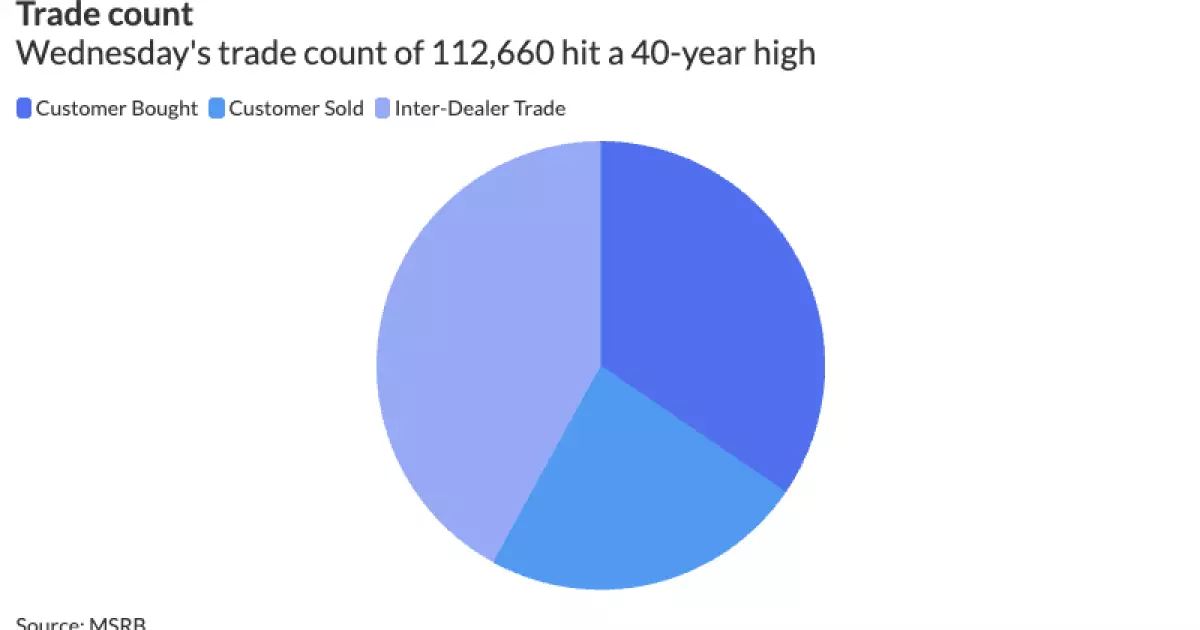In a dramatic turn of events, the municipal bond market is facing unprecedented volatility as we witness dramatic fluctuations triggered by political maneuvers. While some may view this as an isolated incident, the current situation is indicative of deeper, systemic issues that can’t be ignored. Recently, we saw a huge rally in municipal bonds after President Trump’s decision to impose a 90-day pause on his retaliatory tariffs, which temporarily alleviated what has been a relentless storm of financial uncertainty.
The AAA yields seemed to dance at the edge of a cliff, plunging between 30 to 50 basis points. This type of volatility isn’t merely a statistical anomaly; it serves as a worrying signal that even traditional bastions of financial security, like municipal bonds, are not immune to the chaotic pulls of global economics and domestic policies. The essence of investing is to predict risk, and it appears we are witnessing a market that lacks a functional grasp on stability.
The Shadow of COVID-19: Historical Context
Understanding the current climate requires a glance back at historical volatility in municipal bonds. According to statistics, the largest yield adjustments over the last 45 years have been linked to the COVID-19 pandemic and notable financial crises of the past. The emotional peaks and valleys of this market seem to mirror our collective fears and hopes surrounding economic health. The tumultuous weeks in March 2020 are etched into our memory, and concerns appear to recirculate as we encounter new challenges today.
The recent drop in yields was not just a fluke; it came on the heels of a catastrophic performance on Monday, where the asset class recorded its worst one-day return in over 30 years—a staggering loss of 2.85%. The figures speak for themselves: as municipal bonds suffered loss after loss, the recovery responses by investors were more reactive than proactive. Without seasoned strategies to navigate these treacherous waters, many will find themselves adrift.
Liquid Markets or Liquidation? The Dilemma of the Muni Market
What’s alarming is how the conversation around liquidity has evolved since the beginning of turmoil. Industry veterans like Sean Carney have echoed concerns about liquidity crises reaching a critical point. Investors essentially found themselves in a situation where it was impossible to sell bonds, and deals went unexecuted. This stagnation enforced by as little as a 90-day trumpeting of tariffs should send chills down the spine of anyone taking a long-term view on municipal bonds.
To pour salt in the wound, Wednesday broke records in terms of trade volume, but the sheer number masked an underlying malaise. The figures from the Municipal Securities Rulemaking Board (MSRB) indicated over 112,600 trades, but the $32.5 billion that changed hands was still indicative of panic rather than calculated investment. The complexity of liquidity in the municipal market has never been more illuminated, revealing cracks that could turn into chasms.
The Role of Federal Policies: A Double-Edged Sword
Adding a layer of complexity to this crisis are the federal policies set in motion by the current administration. The temporary pause on tariffs, seemingly a breather for investors, is akin to a double-edged sword. While some think it might usher in stability, it could simply be a brief pause in a longer symphony of disarray. With the fundamental issues still lurking beneath the surface, this time frame should be viewed with a discerning eye.
When investors react emotionally rather than rationally, it breeds chaos. The swings we witnessed—where yields rose and fell significantly in a matter of hours—demonstrate that dependence on external factors rather than substantial economic indicators can lead to disastrous outcomes. It’s vital for the players in this market to recalibrate their responses to such abrupt changes.
Technical Conditions: Navigating the Downward Spiral
Despite the tariff extensions, the technical environment for municipal bonds remains weak. Supply has been robust, and though some deals have been postponed, the coming month is set to be challenging. The landscape will not likely stabilize until we reach a natural point of recovery, facilitated by redemptions, maturities, and coupon payments.
Interestingly, while there’s been broad-based selling, the focus seems to be shifting to higher-grade bonds—AAA names, to be specific—indicating a flight to safety that often exacerbates volatility in lower-rated categories. This could stifle the ability of less secure bonds to gain traction even during recovery phases.
The municipal market is presently fraught with uncertainty and instability. It highlights the need for a reevaluation of strategies in an increasingly unpredictable financial landscape. As we brace for what lies ahead, it’s clear that navigating future challenges may require a thoughtful blend of patience and agility. Investors must remain acutely aware that trends may derail with little notice, underscoring that the markets are as much about perception as they are about reality.

